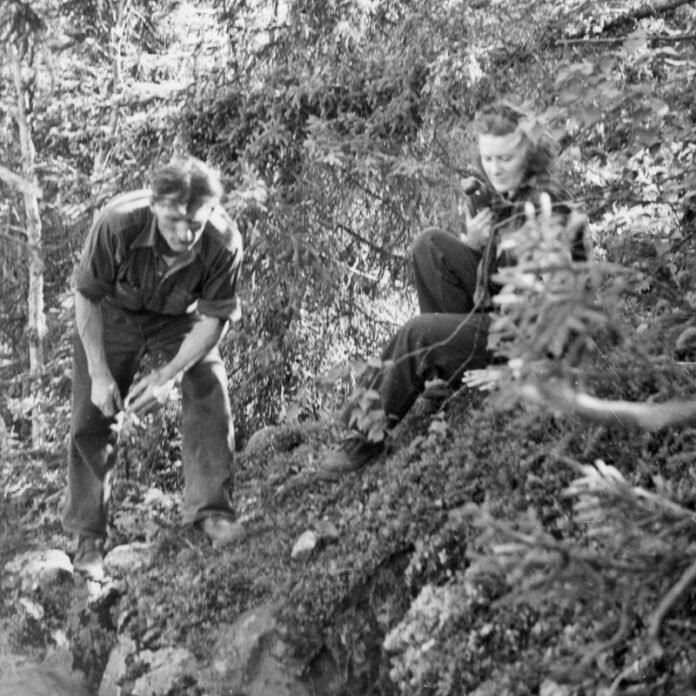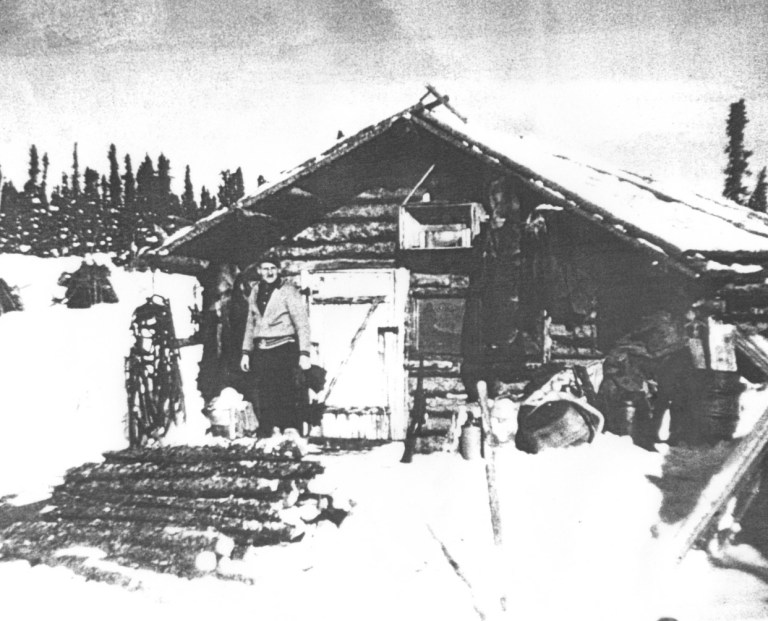
The following is the thirteenth installment in a series about Nan Dorland, a radio star from New York City who struggled to become a writer and a prospector in northern Saskatchewan. Follow at www.nandorland.blogsot.com or on Instagram @discoveringnan.
“Uranium was the cause of the Morenus-Albrecht partnership,” a reporter for the Prince Albert Daily Herald wrote in March 1950. Nan (Danke/Dorland) Morenus left Sioux Lookout in late 1947 and arrived in northern Saskatchewan in the early fall of 1948 to do some prospecting and some writing. Nan may have heard about John Albrecht’s important uranium discovery near Black Lake, Saskatchewan earlier that year and decided to track him down, hoping Albrecht would help her stake claims in the same area that he had found uranium.
Nan first arrived in La Ronge, reportedly to take a prospector’s course. Her hostess in La Ronge, a Mrs. Di Lea, had taken the prospector’s course, a requirement for getting financial assistance under Saskatchewan’s new Prospectors’ Assistance Plan. Nan applied for assistance under that plan, but because she had not yet taken the prospector’s course, the government gave her a time limit to get it done. Instead, she took the name of Mrs. Di Lea who had already taken the course.
At some point that fall, Floyd Glass, a Prince Albert pilot, flew Nan “Di Lea” and an unknown man up to an area west of Stony Rapids. The mystery man may have been “Joe” – the man Nan had gone prospecting with in northern Ontario in the summer of 1947. (He was not her former husband, Richard Morenus; they were divorced in 1947.) I am guessing that Glass flew the couple either to Goldfields or to Fond du Lac. Goldfields, a gold-mining town during the 1930s, saw new life in 1948, serving as a base for the exploration of the new gold: uranium.
Glass provides an account of Nan’s time in Saskatchewan in “A Northern Romance,” his contribution to the book, Gold and Other Stories (1986). He recalls that when he flew in a few months later to see if the couple was ready to come out, Nan’s mystery man ran down to the plane. “He was going out,” Glass recounts. “He said as far as he was concerned he didn’t know what she was going to do, but he thought she was staying.” When Glass went up to talk to Nan, he discovered that “there was no way she was going out. She was up there to find a uranium mine. That’s all there was to it.”

Nan gave Glass some money to pick up a dog team and sleigh for her. He brought her six dogs as well as a net so she could catch fish for the dogs. He thought Nan didn’t know what she was in for, but “she thought everything was fine.” Glass had no way of knowing it, but Nan was by then an accomplished dogsledder.
Nan arrived at Stony Rapids in the first week of December 1948 by dog team. “[The dogs] were tired. And she was tired,” Glass writes. “They had come over thin ice in places where the RCMP told me they didn’t know how she ever stayed on top.” If she had come from Goldfields, she had traveled about 150 kilometres; if she had started out from Fond du Lac, she had traveled 77 kilometres.
It was at Stony Rapids that 37-year-old Nan met 50-year-old John Albrecht. Within a short time, Floyd Glass flew the two of them up to John’s camp on Selwyn Lake near the border of the Northwest Territories and was told to come back in the spring.
The couple spent a year and a half together in northern Saskatchewan dividing their time between Selwyn Lake and Stony Rapids. In May of 1948, the Government of Saskatchewan had lifted the ban on private uranium prospecting. Uranium was the essential ingredient in the development of the atomic bomb. With that in mind, six parties were selected to participate in the province’s Prospector Assistance Plan for the 1949 season, including John Albrecht and Nan “Di Lea.” All six parties prospected in the Black Lake area where John and his former partner, Roy Tobey, had discovered uranium in 1948.
A document titled “Prospectors Assistant Plan, Season 1949” records that Nan and John made several uranium-bearing discoveries at Robins Lake, 50 miles from John’s Nisto find. The report shows that the couple did not make any claims in 1949, however.
Nan told the Herald she “finds Northern Saskatchewan a ‘wonderful place’ and her chosen work ‘just an enormous amount of fun’.” In response to the reporter’s question about who did the housework, Albrecht replied tersely, “Whoever gets back first gets supper ready.”
Contact: joanchamp@shaw.ca

